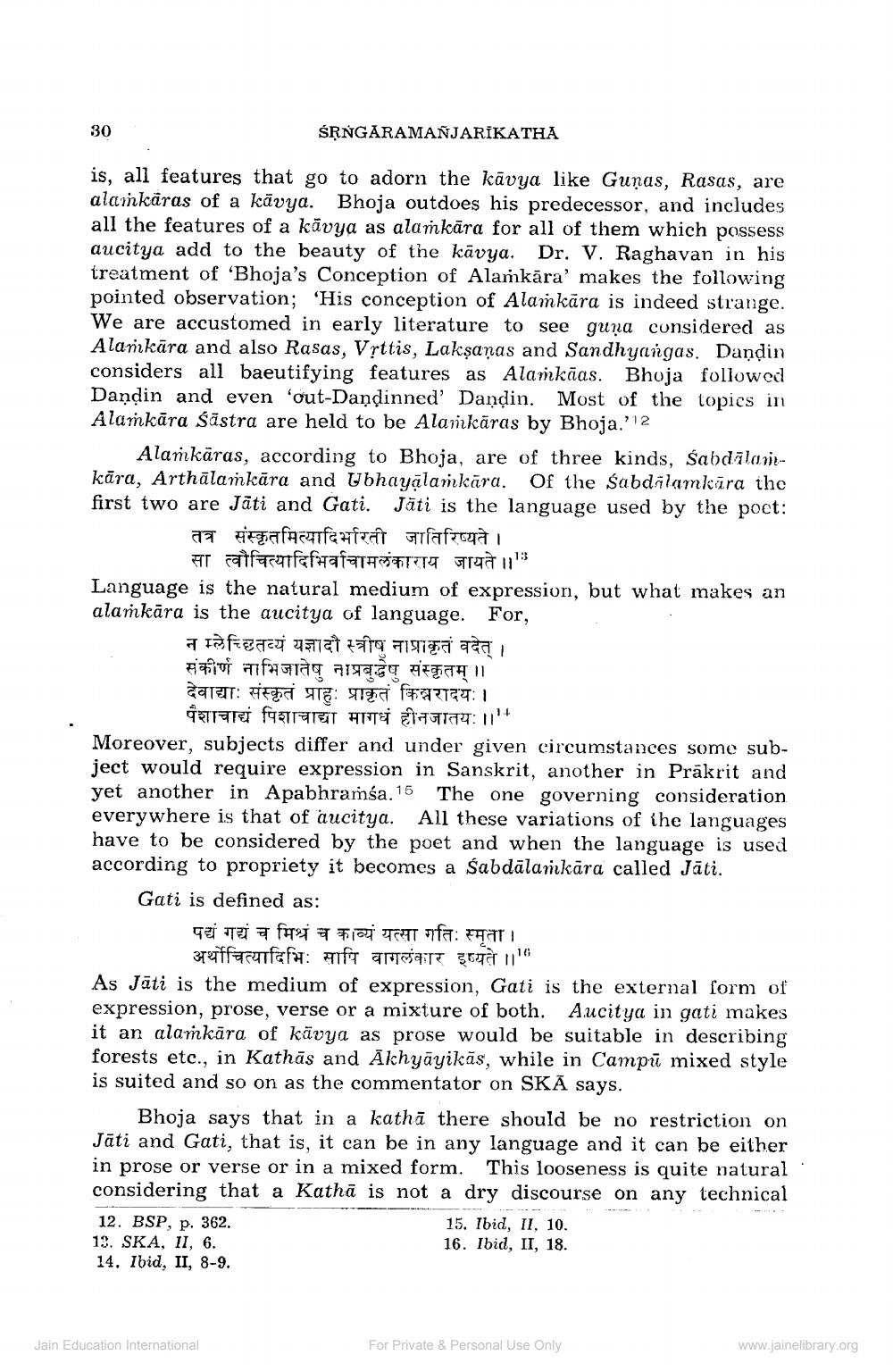________________
ŚṚNGARAMANJARIKATHA
is, all features that go to adorn the kavya like Gunas, Rasas, are alamkaras of a kavya. Bhoja outdoes his predecessor, and includes all the features of a kavya as alaṁkāra for all of them which possess aucitya add to the beauty of the kavya. Dr. V. Raghavan in his treatment of 'Bhoja's Conception of Alaṁkāra' makes the following pointed observation; 'His conception of Alamkara is indeed strange. We are accustomed in early literature to see guna considered as Alamkara and also Rasas, Vṛttis, Lakṣaṇas and Sandhyangas. Dandin considers all baeutifying features as Alamkaas. Bhoja followed Dandin and even 'out-Dandinned' Dandin. Most of the topics in Alamkara Sastra are held to be Alamkaras by Bhoja.'12
30
Alamkaras, according to Bhoja, are of three kinds, Sabdālamkāra, Arthalamkara and Ubhayalamkara. Of the Sabdalamkāra the first two are Jati and Gati. Jati is the language used by the poet: तत्र संस्कृतमित्यादिभरती जातिरिष्यते ।
सा त्वौचित्यादिभिर्वाचामलंकाराय जायते ॥ "
Language is the natural medium of expression, but what makes an alamkara is the aucitya of language. For,
न म्लेच्छितव्यं यज्ञादौ स्त्रीषु नाप्राकृतं वदेत् । संकीर्ण नाभिजातेषु नाप्रबुद्धेषु संस्कृतम् ॥ देवाद्याः संस्कृतं प्राहुः प्राकृतं किन्नरादयः । पैशाचाद्यं पिशाचाद्या मागधं हीनजातयः || "
Moreover, subjects differ and under given circumstances some subject would require expression in Sanskrit, another in Prakrit and yet another in Apabhramśa. 15 The one governing consideration everywhere is that of aucitya. All these variations of the languages have to be considered by the poet and when the language is used according to propriety it becomes a Sabdalaṁkāra called Jati.
Gati is defined as:
पद्यं गद्यं च मिश्रं च काव्यं यत्सा गतिः स्मृता । अर्थोचित्यादिभिः सापि वागलंकार इष्यते ॥ "
As Jati is the medium of expression, Gati is the external form of expression, prose, verse or a mixture of both. Aucitya in gati makes it an alamkara of kavya as prose would be suitable in describing forests etc., in Kathas and Akhyāyikäs, while in Campu mixed style is suited and so on as the commentator on SKA says.
Bhoja says that in a katha there should be no restriction on Jati and Gati, that is, it can be in any language and it can be either in prose or verse or in a mixed form. This looseness is quite natural considering that a Katha is not a dry discourse on any technical
12. BSP, p. 362.
13. SKA, II, 6. 14. Ibid, II, 8-9.
Jain Education International
15. Ibid, II, 10.
16. Ibid, II, 18.
For Private & Personal Use Only
www.jainelibrary.org




